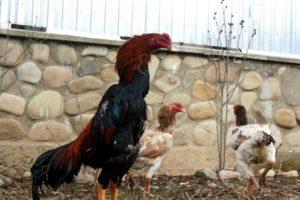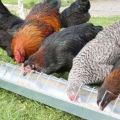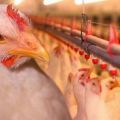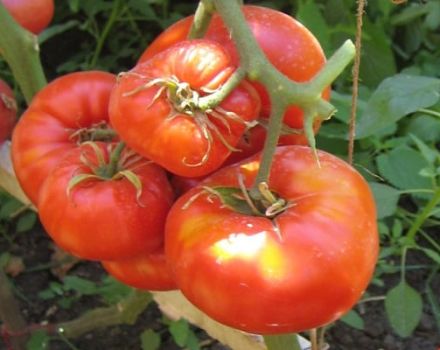Descriptions of the 15 best meat breeds of chickens for breeding at home
Household products are of high quality, are in demand in the market and contribute to the family's budget. Novice poultry farmers or experienced breeders may be interested in meat breeds. Consider the advantages of breeding them in the conditions of a personal and suburban economy, which breeds are better to start, the features of their maintenance.
Features of meat breeds
Meat varieties of chickens are larger than egg ones, less mobile, and behave more peacefully in chicken coops. It is important for households that they are not very susceptible to multi-factor stresses, they quickly gain weight, and several types of products can be obtained from them - meat, eggs, feathers.
History of origin
Chickens, which produce a lot of high quality meat, at the same time with the ability to incubate large eggs, have long attracted people who have been purposeful selection of breeds - selection. This is how Brahma and Cochinhin appeared in Indochina. These chickens are beautiful conformation, and many breeders keep them as decorative birds.
Purposeful selection for the industrial production of meat chickens began at the end of the 19th century, in England and France, and then in the USA. The main goal of the breeders was to obtain fast-growing poultry, well adapted to local growing conditions. This is how the Dorking breed appeared (from the crossing of aboriginal chickens with the variety brought by the Romans).
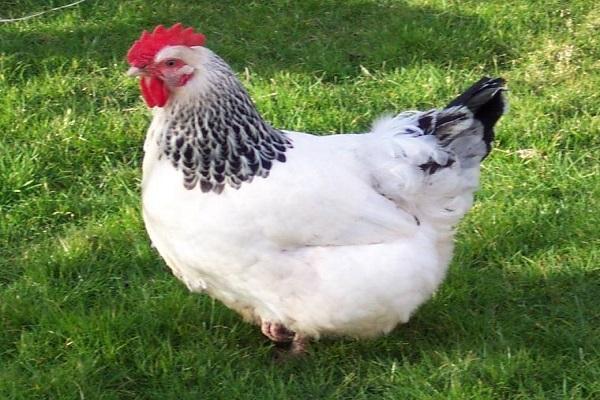
Birds of the Cornish breed were bred in England and remained fighting for a long time. In France, by crossing the Brahm, Gudanov, Cochinchin and silver Dorkings, the Faverolle chickens appeared.
Today, meat breeds are used to create broiler crosses that are characterized by rapid weight gain and soft dietary meats, such as the offspring of the Cornish and Plymouthrock lines. The Sasso colored broiler was introduced about 35 years ago and has firmly conquered the French meat markets.
A separate selection line was the selection of miniature meat chickens, which were fashionable to keep even in city apartments. Chickens with dwarf genes were selected from breeds such as Plymouth Rock, Egg Leghorn, Cornish and Rhode Island.

Advantages and disadvantages
The advantages of meat breeds include:
- rapid growth of individuals and weight gain;
- high dietary properties of meat;
- large eggs can be obtained at the same time;
- high market value of carcasses.
Disadvantages of breeding meat chickens:
- high demand for feed and vitamin and mineral supplements;
- some breeds are susceptible to infections.
As you can see, there are more advantages in breeding these birds than disadvantages.
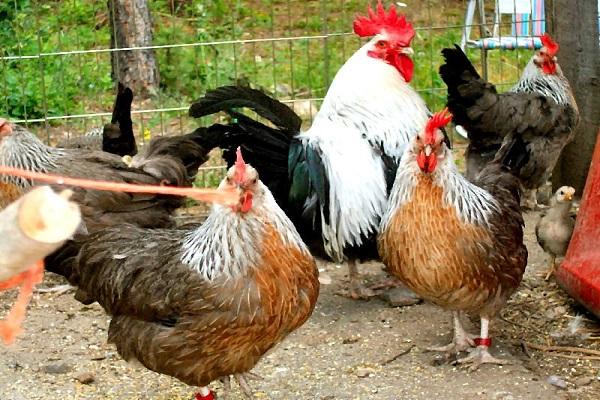
Popular varieties
Consider the best breeds that are suitable for growing for meat in personal subsidiary plots and in summer cottages.
Ameraucana
The breed is of American origin. Chickens lay eggs of blue, pink, greenish color. The color of birds is varied - from white to blue and dark yellow. The weight of the roosters is 3, the hens are 2.5 kilograms. Egg production - 200-350 eggs per year, weighing 60-65 grams.
Brama
It features powerful paws with plumage, strong wings and a large fluffy tail. The body color is white, the neck is black and white or gray, the tail is black. You can find birds with beige plumage. The crest is medium-sized, fleshy, powerful yellow beak. Hens per year give, on average, about 100 large eggs over 60 grams. The weight of the hens is 3.5, the roosters are 4.5 kilograms. The bird is thermophilic, but continues to rush in winter. Requires a large amount of food rich in proteins, fats and vitamins.
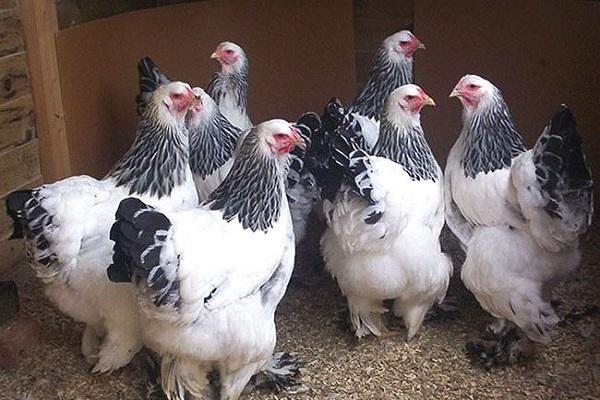
Hungarian giant
Large chickens with a rounded body of red-brown color. Gain weight quickly. Carcasses of an attractive appearance. Rooster weight - 4-4.5, chicken - 3.5-4 kilograms. The bird is ready for slaughter at the age of 3-4 months. Egg production - up to 200 eggs per year, beige, weighing 55-60 grams.
Bress gallic
An ancient French breed, the history of its breeding is about 500 years old. The white cockerel of this particular breed has become a symbol of France, its profile even appeared on the coins of the republic. It features blue paws and a bright red crest. A breed with a high degree of adaptability to housing conditions. Rooster weight - 5, chicken - 4 kilograms. Egg production - 240 eggs per year, with a weight of 60 to 85 grams.
Gudan
French breed, distinguished by white juicy meat with thin bones. On the head there is a distinct crest, which is why this variety of chickens is highly decorative, especially in combination with a variegated color. The weight of the rooster is 3.6, the chicken is 3.2 kilograms. Egg production - up to 150 pieces per year, egg weight - 45-60 grams.

Jersey giant
A difficult cross, bred in the USA by crossing Brahma, Orpington, Langshan and others. The color is black, white, blue with a green tint. The ridge is six-toothed, even, red, the beak is dark. Birds of a calm temperament, do not fly. Layers often throw away or crush newly laid eggs with their weight, so they need inclined planes in their nests - slopes.
Requires a lot of balanced feed. The main advantage of these birds is a quick weight gain. By the age of 7 months, the weight of males reaches 5, females - 4 kilograms. Egg production - up to 180 pieces per year, with an average egg weight of 65 grams.
Dorking
The English breed, known since the end of the 19th century, has high decorative qualities. The color is varied - from variegated to bright white, brown and black-blue individuals with a wide body. The comb in roosters is red, fleshy, vertical, and in females it hangs on its side. The beak is light. Roosters weigh 3.5-4.5, chickens - 2.5-3.5 kilograms. Egg production is 120-140 eggs per year, with an average egg weight of 66 grams. Birds are susceptible to infections that cause encephalitis, so the chickens are vaccinated.

Cornish
White Cornish is widespread. Paws without plumage, yellow with beak. The carcass produces well-shaped breasts. This variety provides the highest economic efficiency of cultivation. Birds have high growth rates with relatively low feed intake. The American Poultry Association has named the Cornish the standard for beef production. The weight of roosters is 3.5-5, chickens up to - 3.5 kilograms. Egg production is 140-170 eggs per year, the average egg weight is 55 grams.
Note! With insufficient walking, birds of this breed suffer from obesity. Too fatty carcasses are not in demand in the market.
Cochinhin
Stable chickens with powerful legs, completely covered with plumage. Color - from red to gray, variegated and gray-black. The beak is yellow. The transition from the head to the torso with a strong bend, which makes the head appear high, with a proud posture. They tolerate winter well in warm sheds, can do without walking, are inactive, do not fly. The mass of chickens is 4, roosters - 5 kilograms. Egg production is about 100 eggs per year, with preservation and a slight increase in the number of eggs in winter, the average weight of eggs is 55 grams.
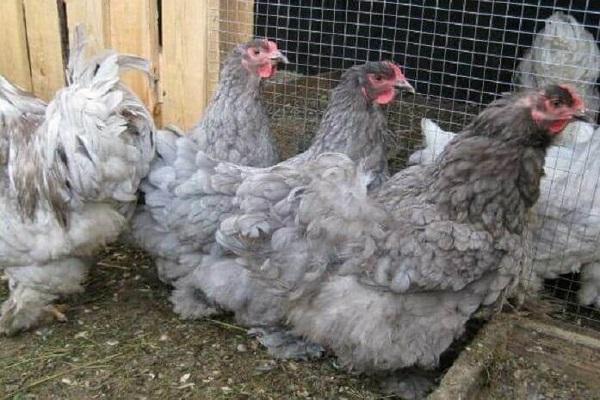
Langshan
The breed comes from northern China, obtained by crossing Minoroc and black chickens. There are two known varieties:
- English fur-legged (suitable for free walking in the country);
- German barefoot.
The body is tall, birds have a proud posture. The mass of roosters is 4, chickens are 3 kilograms. Egg production - 110 pieces per year with a weight of 56 grams.
Mini
Red-black, fawn and white colors are widespread. They are characterized by low feet, which is why they should not be allowed out for walking in wet weather. The eggs retain the same weight as normal individuals. Roosters reach a weight of 3, chickens - 2.7 kilograms. Egg production - 180 pieces per year, average egg weight - 60 grams.
Orpington
They are distinguished by a massive stocky body, soft white, red, gray, marble, black or black-bordered (gold-bordered) feathers. The color has many other varieties. The head is small, the paws are without plumage. A small amount of fat accumulates in meat, which is why it is highly valued. The weight of the cockerels is 4-4.5, the hens are 3-3.5 kilograms. Chickens produce up to 160 eggs per year, with an average weight of 50 grams.

Plymouth Rock
An American breed that produces excellent quality meat with a well-developed breast, gains weight quickly. The most common white Plymouthrocks - they adapt well to the climate, start to rush early. The breed can be considered as meat and egg. The comb is four to six-toothed, straight, red. The beak is yellow-gray, the iris of the eyes is orange. The weight of the roosters is 4.5, the hens are 3 kilograms. Egg production is 160-200 eggs per year, the average weight of one egg is 60 grams. The variety is highly immune, it needs walking.
Sasso
Highly productive cross, daily growth of chickens reaches 60 grams. It features a large body. Paws are powerful, bare. The color is reddish, black, fawn, variegated. The mass of roosters is 5, chickens are 4 kilograms. Egg production - 120 eggs per year with an average weight of 55-60 grams.
Faverol
An elegant French breed of meat chickens. Differs in low paws with five toes, covered with feathers, a small tail. The color is varied, salmon or the so-called "Colombian silver". The beak is very short, powerful, light-colored. Carcasses are easily plucked, the meat is tender, tasty, slightly reminiscent of game. Chickens need free range, plants do not pick. The mass of roosters is 3.5-4, chickens are 2.5-3.5 kilograms. Egg production is 160-180 pieces per year, the average weight of eggs is 55-60 grams.

Features of maintenance and reproduction
It is important for beef birds to keep the chicken coops clean. The litter should be sawdust or straw. The old bedding is regularly removed, scrubbing down to the base of the floor, and a new layer is added. Meat poultry should be allowed to walk. Chickens without movement are prone to obesity, which leads to negative consequences for housing.
Important! Chickens cannot tolerate high humidity in a chicken coop. Clean and ventilate the area regularly.
Meat chickens are wonderful hens. Young animals are kept in a room with an air humidity of 50-60 percent. In the early days, the chickens are fed hard-boiled yolks.
Which breed should you choose?
Novice poultry farmers are advised to opt for the White Plymouthrock breed, since it is the most unpretentious. A balance in feed cost and carcass weight is achieved with the Cornish breed.The best option for the cost of feed, the occupied area, the yield of meat and eggs is provided by mini chickens.

